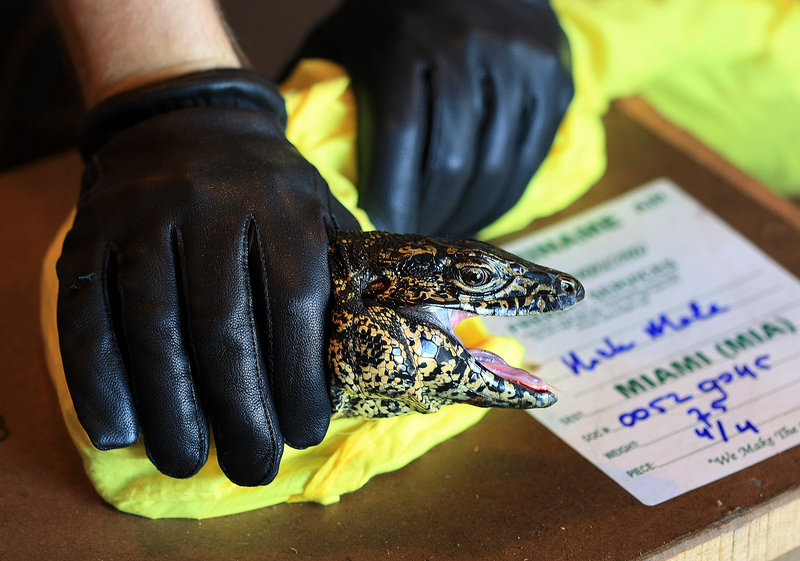FORT LAUDERDALE, Fla. – They arrive from Amazon rainforests, central African savannahs and south Asian jungles, crated passengers in the cargo holds of airliners.
Spitting cobras, common death adders, Zanzibar dwarf geckos, green iguanas, chinchillas, emperor scorpions and hundreds of other non-native species enter the United States each year to serve the demand for unusual pets.
A lot of time has gone into the unsuccessful campaign to clear the Everglades of Burmese pythons, just one of the non-native species to find a congenial home in South Florida.
But the federal government continues to allow wide-open imports of a vast range of wildlife, conducting few screenings for disease and permitting most shipments to enter without inspection. A report on wildlife imports by the Government Accountability Office last month found “gaps that could allow the introduction of diseases into the United States.”
TYPHUS, VENOM AND DEATH
A Sun Sentinel review of live wildlife import records from 2004 through April of 2010 found that the United States imported these animals:
• More than 739,000 rodents, despite warnings from the U.S. Centers for Disease Control and Prevention that rodents can transmit to humans diseases such as hantavirus, bartonella and typhus.
• Nearly 20,000 venomous snakes, among which are some of the most deadly, including 632 puff adders, 113 black mambas and 357 king cobras.
• More than 1.2 million green iguanas, as well as other species that have become established in the United States, including 39,673 Nile monitors and 20,806 Burmese pythons. Several of these non-native species kill native wildlife.
A bill in Congress would have restricted imports to those species that had been approved as harmless, but an outcry from wildlife owners and the pet industry defeated it. The U.S. Fish and Wildlife Service is completing the process to declare the Burmese python and eight other big snakes injurious species, which would end imports except for zoos and a few other purposes.
Environmental and animal welfare groups say the python proposal has come too late to help the Everglades, and they call for import limits to keep out the next harmful species.
“If the federal government had listed the Burmese python as injurious 20 years ago, we wouldn’t have had this problem,” said Beth Preiss, exotic pets director for the Humane Society of the United States. “It may be too late to stop the invasion of the Everglades, but it’s not too late to stop it in the rest of the U.S.”
But the pet industry and hobbyist groups have fought back. They note that a cold snap last year killed a lot of Everglades pythons. They say import limits represent an extreme response to problems caused by a few species. And they say tough restrictions would cost jobs and undermine a pastime that fosters in children an appreciation of science and nature.
OPPORTUNITIES TO SUFFER
“A lot of children spend hours in front of the TV and the computer and have very little contact with nature,” said Jamie Reaser, vice president of environmental policy for the Pet Industry Joint Advisory Council, a trade group. “So I think it’s very important children have the opportunity to learn about animals and the environment.”
D.J. Schubert, wildlife biologist for the Animal Welfare Institute, said the import business is riddled with opportunities for animals to suffer.
“They can be held for a long time without water or food,” he said. “Frequently they’re held in boxes or burlap sacks. The entire industry facilitates cruelty, not because people are trying to be mean, but because they don’t know any better.”
A raid last year by the U.S. Fish and Wildlife Service found horrific conditions at U.S. Global Exotics in Arlington, Texas, with more than 26,000 snakes, hamsters, wallabies, sloths and other animals crowded into filthy cages without food or water, many dead or dying.
Reaser, of the pet trade group, said that case was an exception in an industry that works hard to keep its valuable cargo safe.
“A lot of people in the pet industry got into it because they really love animals,” she said. “There’s an economic investment, and it doesn’t make good business sense not to care for the animals.”
SCREENING ANIMALS NOT PRACTICAL
About 60 percent of infectious diseases emerging in humans since 1940 — including AIDS and severe acute respiratory syndrome — originated in animals, making the jump to people through live-animal markets, the butchering process and the pet trade.
Monkeypox, a viral disease from Africa, appeared in people in the United States in 2003, arriving in a shipment of rodents from Ghana to Texas.
The CDC banned rodent imports from Africa, but the pet industry found other sources. Since 2004, more than 739,000 dwarf hamsters, chinchillas, golden hamsters and other rodents have been imported, , according to the Sun Sentinel’s review of import data.
The U.S. Fish and Wildlife Service said it’s not practical to screen millions of animals for diseases. The service has 124 inspectors at 38 entry points to watch for smuggling, improperly packed animals and banned species. Adding disease to the list would be “tough,” said Edward Grace, deputy chief of law enforcement for the Fish and Wildlife Service. “Our inspectors don’t have the veterinary skills to determine if an animal is ill or may be a disease vector,” he said.
Send questions/comments to the editors.



Success. Please wait for the page to reload. If the page does not reload within 5 seconds, please refresh the page.
Enter your email and password to access comments.
Hi, to comment on stories you must . This profile is in addition to your subscription and website login.
Already have a commenting profile? .
Invalid username/password.
Please check your email to confirm and complete your registration.
Only subscribers are eligible to post comments. Please subscribe or login first for digital access. Here’s why.
Use the form below to reset your password. When you've submitted your account email, we will send an email with a reset code.